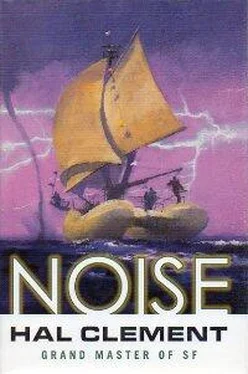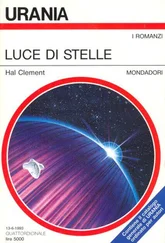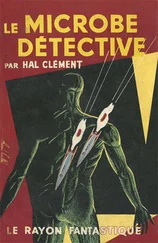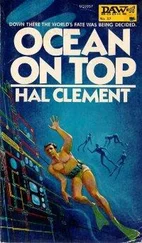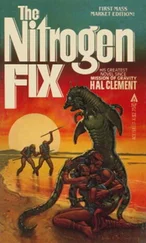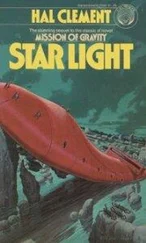’Ao was perfectly right. They were lying on what seemed to be packed hailstones varying from pea to golf-ball size, though only Mike made that comparison, of course. He thought rapidly, for him.
Hailstones. Circular area. Level area. Too-low-for-lightning area—that was a problem. No, it wasn’t. He’d merely been wrong about the thing’s rising.
Most uncharacteristically, he spoke his idea aloud. Perhaps, he thought later, it was because the captain wasn’t in hearing, and of course it was something Kainuians might reasonably not know about.
“More water we don’t need to worry about,” he remarked rather illogically. “You’re right, ’Ao. This is hail.”
“But why so level, and just here, and in a circle?” The question came from Keo, Hoani was glad to note.
“It’s collected in a lightning crater, I’d say. Explosion pits tend to be circular, and when lightning hits ice you get an explosion—”
“Then we’d better get back downhill!” exclaimed Keo. “I didn’t think we were high enough for lightning! Hurry, ’Ao. You go first, and keep your safety line taut!”
“You may be right, and I suppose we should play it safe,” countered Mike, “but I don’t think so. It’s been a pretty long time since this crater formed—”
“If it really is a crater,” cut in ’Ao. “We can only see the top, and don’t know how deep it is, or was.” Mike was nonplussed for a moment, then started to talk again, not quite so rapidly.
“It’s nearly a perfect circle, as I said,” he pointed out. “Can you think of any other reason that would be? Anyway, if it is a lightning pit it was formed long enough ago to fill with hail, and I think this berg was probably higher then. Quite a lot higher. You yourself, Keo, were pretty sure we’re still below lightning-risk height. We’re certainly not a hundred meters above sea level yet.”
The mate thought for perhaps half a minute. Mike suspected that Keo, like himself, was wondering less about what the captain would do if she were there than what she would say later—whatever they actually did now. Mike himself was simply not constituted by habit to regard lightning as a major hazard, though his mind told him this was rather silly in the present circumstances.
’Ao, content with the fact that the decision wasn’t up to her, was examining the edge of the supposed hail deposit. The ice over which the men had climbed was clear enough to see into for half a meter or more, and she was wondering whether there were coral spicules in it this high up. It took her only a few seconds to find them, and virtually no time thereafter to see something else.
“Keo! Mike! Look here! There are lots of the coral things up here, too, but they’re not all lying flat. They’re all jumbled around. Look!”
They looked. ’Ao had spoken after looking at perhaps a meter of the circle’s circumference; her elders were silent until they had checked over half the circle, uphill as well as downhill portions. The child seemed to be right, however—perhaps unfortunately, it occurred to Mike. He decided not to report her somewhat hasty leap to a conclusion if he could help it; Wanaka might well decide that a deduction of points was in order, and ’Ao had actually been a little more guilty of unreasonable haste than had Mike himself.
To reinforce this determination by making himself guiltier, he spoke again.
“I’ll bet those spicules were as flat and organized originally as the ones down below. They got knocked around by the blast that formed the crater, wouldn’t you say?”
Keo shrugged, a gesture much more visible through his noise armor than through Mike’s.
“Maybe. But aren’t the spikes pretty regular for explosion debris, though? They’re mostly pointing toward the center of the circle. But that doesn’t matter right now. We’re going down to report. ’Ao, I have another line. Take the end of it so we can both hold you back if we have to, and lead the way.”
The child fell twice during the descent, clearly not from injudicious rope tugging by either man, which made Mike feel better about her original fall. Mike himself slipped once, fortunately on a fairly shallow slope so that Keo was able to stop him with little difficulty, and in half an hour or so the three were back aboard Mata .
Mike had been a little worried, but Wanaka said nothing about their having climbed out of sight. She had, after all, issued no orders on that point. She simply listened to the accounts of all three of the investigators. Mike did feel a little of his usual self-consciousness when he had to describe his own theories, but not very much; he was fairly confident in them by this time.
His old uneasiness did not return in full strength until he had finished, and the captain asked a question.
“I’m not quite sure whether all this theorizing depends on whether the berg, or whatever it is, is rising or sinking. Can you straighten me out, Mike? Someone”—Hoani was grateful that no names were mentioned—“suggested a while ago that it must be rising because a lot of the lower slopes seemed to have been smoothed by wave action. Then I hear that the top used to be up in the lightning region and is now lower.”
Mike hesitated, all his old uncertainties back in full force. Certainly the berg was both rising and falling over a period of a few minutes, unless it was merely the water falling and rising; but over a long term there was no way yet to be sure. Before he could think of any sensible answer he was rescued by what he regarded as the second least likely source.
“It could have been a lot bigger before, and turned over more than once like the others,” suggested ’Ao.
“Did the others show any signs of being grown by people, like this one?” asked the captain.
“Not that I saw, unless their coral counts—I know it was all irregular on the others—but does that mean they weren’t?” Mike’s impression of the child’s intelligence was rising with each word, though he had never regarded her as stupid. Wanaka showed no change of expression, but her next question was directed to Keo.
“You’ve been trying to tell whether this one is rising or sinking. I haven’t seen enough change myself to mean anything, but I haven’t been as careful as you. Has there been any motion you could distinguish from ordinary wave motion or float oscillation?”
“No. Not yet. We haven’t been here very long, though. I don’t see that it’s important; the thing’s certainly not going to roll over on us anytime soon.”
“It’s important just the same. We’ll take some”—she hesitated for just a moment—“water pods, and set them just at the edge of this thing, a hundred meters or so apart, all the way around it. We can probably get them back, since they float, and if we don’t, you say there’s plenty of hail up in that crater. We’ll learn the size and shape of this thing, too, while we do that. Mike and ’Ao, start collecting coral spikes; we can drive them into the ice at the water’s edge to hold the pods. Give each one a couple of meters of mooring line; there has to be some change of height because of waves, and we don’t want the floats washed away. The anchor spikes will be the real reference, of course, and the pods will make them readily visible. Get to it. Keo, to the sails, dead slow. I’ll take the helm.”
Mike was not quite as certain as Keo about the stability of the berg, but didn’t argue. With the child, he started collecting coral spicules.
The project took more than two days. It proved quicker to let swimmers do most of the work; maneuvering the ship next to the ice was extremely tricky, neither waves nor wind nor bobbing ice, if that were actually involved, being very cooperative. The berg proved not to be quite circular, and they didn’t measure the hundred-meter separation of the marks very carefully since no one thought that data important. Its circumference seemed to be about seven kilometers.
Читать дальше
